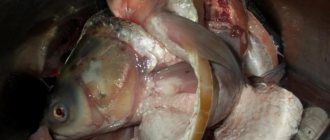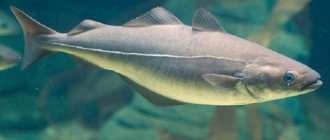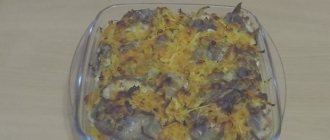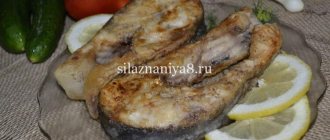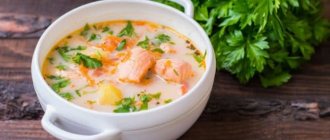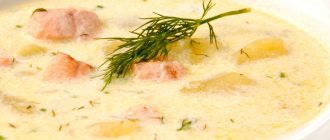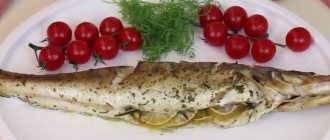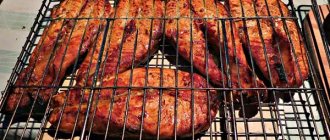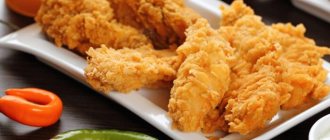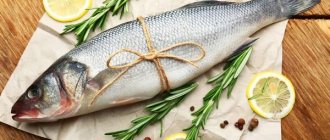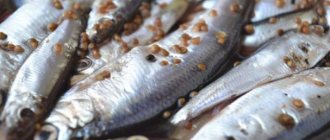Salting fish can significantly increase its shelf life and give it a special taste. Pike perch, depending on its size, is salted whole or in pieces, sometimes with the addition of spices for salted consumption or for subsequent smoking or drying. And also, the caviar of this fish is salted separately, and in various ways. Before salting pike perch, it must be prepared.
If it is permissible to salt a small fish entirely - without gutting or cutting it up - then the entrails of a large fish must be removed, although the head can be left.
Having completed the primary processing, the fish must be sprinkled with salt, seasoned with spices and pressed. After 10-12 hours, brine or brine is formed, which is drained after 5 days, and the fish is used for food, dried or smoked. There are a lot of homemade salting recipes, and they differ in the amount of salt, different proportions of spices and herbs. Fresh fish, caught independently or purchased specifically for these purposes, is salted.
Salting fish ensures its preservation for a long time, as it prevents the penetration of bacteria. To do this, take 140 g of salt, bay leaf, allspice for 1 kg of pike perch and start salting:
- First, the mucus and entrails are washed off the fish with a hard sponge. Heads or gills - optional.
- For large fish, cuts are made along the ridge so that the salt penetrates evenly and washed.
- Rub thoroughly with salt, not forgetting the abdomen, gills and cut.
- Then they place it belly up in an enamel bowl or wooden barrel, sprinkling the rows with salt and spices. In this case, there should be slightly more salt in the upper part of the container than at the bottom.
- Cover with a wooden circle or flat plate and place the weight.
- Take it to a cool place.
On a note!
For large specimens it will take 7-8 days, for small ones – 3-5 days.
To prepare salted pike perch according to an old recipe, you will need to take:
- 8 kg pike perch;
- 50 g dried hops;
- 10 g cloves;
- Bay leaf;
- 10 g allspice;
- 10 g black pepper;
- 2.5 tbsp. coarse salt.
Pour a little salt into the bottom of the pan and place the pike perch prepared as in the previous recipe. Then lay the fish very tightly and sprinkle each layer with salt. Place a weight on top and take it to a cool place.
How to pickle pike perch for hot smoking
To make the meat of smoked pike perch more juicy, the scales do not need to be removed, limiting yourself only to removing the entrails and gills.
If you can’t catch fish yourself, you can buy it. In this case, you should be guided by the following rules:
- The size of the carcasses should be approximately the same.
- Frozen or chilled fish should be free of visible damage, mucus and unpleasant odor.
- The eyes are clean, transparent, the gills are bright red or pink.
For hot smoking, it is enough to use a quick salting method. The fish is rubbed with salt from the outside and inside, and placed under pressure. After 2-3 hours it is ready for hot smoking. You should not be afraid to oversalt the pike perch - it will not take more salt than it needs. But under-salted fish will not be as tasty as we would like.
With hot smoke (90-100 degrees) and served hot. Shelf life in the refrigerator is 3 days.
Salting for withering
For drying, it is better to take medium-sized fish of medium fat content - it does not need to be gutted. If the pike perch is large, then it will have to be gutted and cut crosswise into 150-200 g pieces. The fish is salted in the same way as in the previous recipe - dry or in brine. In the latter case, the brine is prepared at such a strength that a raw chicken egg floats on the surface. Then they pour it over tightly packed pike perch, put it under pressure and take it out into the cold. After 3 days you can start soaking and drying.
How to wilt pike perch
If drying occurs in winter, you can hang it in the kitchen near the stove.
Salted carcasses should be washed with cold water. If the density of the pulp is very high, then it is better to soak it for 6-12 hours, changing the water 2-4 times. When the pike perch begins to float, it means it is ready for drying. For this:
- the carcasses are lightly dried on soft paper or newspaper;
- strung on twine or cord;
- grease with vegetable oil or table vinegar;
- hang in boxes covered with gauze;
- place in a shady, well-ventilated place.
If drying takes place in winter, you can hang it in the kitchen near the stove. The optimal temperature for the process is 20 degrees, the time is from 2 weeks to 1 month. If you want more fat to remain in the fish, it is better to hang it upside down.
How to pickle pike perch caviar
If the caviar is frozen, it should be thawed; fresh caviar should be removed from the fish. For 600 g of caviar you will need to take:
- 3 liters of boiling water;
- 6 tbsp. l. salt;
- 2 tbsp. l. vegetable oil.
The cooking process consists of several stages:
- Chop the caviar in the eggs with a knife in several places.
- Pour boiling water over, stir with a fork, wrapping the film.
- Place in a fine sieve.
- Pour 2 full tablespoons into water (2 liters). l. salt and boil.
- Pour the hot brine over the caviar and continue to collect the remaining film with a fork. At the same time, the pike perch caviar will change color.
- Repeat the procedure 3 times. At the end the caviar will become very light. Almost white.
- Pour half the vegetable oil into a sterile jar, then put the caviar and pour the rest of the oil on top.
- Place in the refrigerator.
After 6-8 hours, the delicacy is ready to eat, preferably on sandwiches with butter.
Salted pike perch caviar, benefits and harms
Punched caviar is obtained by punching it through a sieve or screen, thereby removing the gaps.
To salt pike perch caviar in this way at home, you should take:
- 1 kg of caviar in eggs;
- 120 g salt;
- 20 ml vegetable oil.
Rub the caviar through a sieve, add salt little by little, stirring constantly, pour in the oil, and place in the cold. After 3 days the product is ready for use.
Caviar has a high content of protein, lecithin, vitamins A, D, group B and many microelements (iron, magnesium, phosphorus, potassium, molybdenum, fluorine). It is recommended for people with weakened immune systems, in the postoperative period, with cardiac pathologies and impaired hematopoietic functions. Despite all the usefulness of the product, you should not eat more than 5 dessert spoons per day, since the nutritional value is almost 100 kcal per 100 g.
Pike perch caviar contains many microelements, easily digestible protein, and healthy vitamins. Delicious in any form. It is fried, baked, made into pancakes and cutlets. Served on the festive table and used for everyday use. Homemade pickling of pike perch caviar is simple. Salted caviar is especially tasty immediately after cooking. It is prepared for future use and stored for several months. Salted caviar is delicious with butter and herbs.
A few tips on how to pickle and preserve caviar
Now you know how to properly salt pike perch caviar at home. Now you need to put it in a dark and cool place so that it can be preserved for as long as possible. The best place for this purpose is the refrigerator. Lightly salted can remain there for several days. If the volume is small, then it is just enough for the whole family
Heavily salted can be stored for up to a month. You can slightly extend the storage time by filling the caviar with vegetable oil, in a layer of no more than 1 cm. If there is a lot of caviar, then some can be frozen in portions. Then, as needed, remove from the freezer to then pickle.
Salting pike perch caviar
The thicker and fattier the pike perch, the better its caviar tastes. Fresh caviar is salted. Caviar from thawed carcasses tastes much worse; it is better to cook other dishes from it.
First, the caviar, packed in film (yastyki), should be carefully removed from the fish carcasses, remembering the unpleasant consequences of a bile spill, which will significantly spoil the taste.
The oysters are washed, freed from mucus and prepared for salting. It can be in two forms:
- Ambassador of caviar mass.
- Salting caviar in eggs.
How to salt pike perch caviar in the form of a homogeneous mass
- The first operation is punching, freeing the calf from the film
There are different methods, which one you like best.
- Winding the film onto a fork or knife.
- Rub through a grater with smooth holes, a sieve, a colander. The sharp edges of the holes will ruin the shape of the eggs.
- Scrolling through a meat grinder.
- Pouring boiling water causes the pieces of film to curl up, and it merges with the water.
The latter method guarantees the destruction of germs and pathogens. Scalded or steamed caviar is the safest. After pouring boiling water over the caviar, stir it for several minutes and steam it at the same time, then rinse with cold water until all the pieces of the film are washed off.
- Second operation - ambassador
Quick Ambassador
After punching, the eggs are washed several times with cold (or ice) water until the drained water becomes absolutely clear. Then simply add salt and pepper (salt like a regular dish), mix well, and let sit. After a few hours, the caviar is ready. You should be on the safe side: start eating not after three hours, but wait 5-8 hours.
Second option. The punched caviar mass is placed in a colander or sieve. Scald the caviar with boiling water, immediately rinse with cool water and allow the remaining water to drain. Place on a napkin to dry slightly. Then transfer to a bowl, add salt and white pepper, lemon juice and a little vegetable oil. After cooling, the dish is ready for sampling. The result is five-minute lightly salted caviar.
Salting pike perch caviar in brine
A more labor-intensive and safer method is to salt the caviar in brine. For every liter of water take 100 g of salt.
Boil several liters of water (2-3 times more than the volume of caviar), add salt, stir the solution vigorously until the salt is completely dissolved. Boiling brine is poured into the caviar, after three minutes the liquid is drained, and the caviar is thrown onto a sieve to allow the remaining liquid to drain. Place into jars. After three hours you can eat because the caviar has been treated with boiling water. Store for several days.
For long-term storage, vegetable oil is added on top to prevent air from entering. It’s even better to first pour the boiling solution over the caviar three times, each time preparing a new portion of water and salt. Well-steamed caviar with a pleasant golden hue. If you don't steam it enough, it turns out cloudy.
Another option. Place the caviar in boiling brine (or add brine). Cover tightly with a lid, let simmer for 15 minutes - not on fire, just keep in boiling brine! Then rinse in several waters until the water is clear and clean when drained.
Pike perch caviar - the salting and processing recipes are different, so the finished dish tastes different. The taste is also slightly modified due to additives when serving.
- Eating or serving salted caviar to the table
Each person has their own preferences. Most often, crumbly caviar is mixed with vegetable oil, finely chopped onion is added, and served with herbs. The caviar mass is spread on pieces of white/rye bread, covered with a layer of butter. Or they spread the caviar on toast rubbed with garlic. Cold and hot sandwiches are sprinkled with chopped herbs on top.
How to salt pike perch caviar in films
The yastyki are dipped in salt and laid out in rows, sprinkling each row with salt. Leave to salt in a cool place for two weeks. Then they are thoroughly washed and eaten. If salted eggs are slightly dried, their taste will resemble caviar taken from dried fish.
These are the basic recipes for salting pike perch caviar - the same as the methods for salting many other varieties of river fish.
They will allow you to purchase any fishing goods at competitive prices!
Subscribe to us - through them we publish a lot of interesting information, photos and videos.
Popular sections of the site:
It will allow you to understand how all fish bite depending on the time of year and month.
The page will tell you about many popular tackles and devices for fishing.
We describe in detail living, plant, artificial and unusual.
In the article you will get acquainted with the main types, as well as tactics for using them.
Study everything to become a real fisherman and learn how to make the right choice.
Salting is one of the common ways to preserve fish. Since salt extracts excess moisture from it and prevents the growth of bacteria. This method allows you to keep the product edible for a long time. You can salt almost anything: carp, bream, kutum, roach, and other species. Often fishermen like to pickle pike perch
. It is only important to follow a number of rules that will help you do this correctly.
Choose your recipe
How to cook jellied fish in a slow cooker?
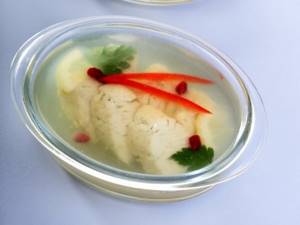
Any dish prepared in a multicooker acquires a richer taste; you just need to select the right program.
Ingredients:
- Pike perch – 800-1000 gr.
- Carrots – 1 pc.
- Onion – 2 pcs.
- Gelatin – 30 gr.
- Spices (allspice, black pepper, bay leaf) - to taste.
- Salt - to taste.
- Greenery.
Cooking process:
- We cut up the fish. We cut off the head and fins, and separate the pike perch fillet from the bones. Be sure to remove the gills and eyes from the fish head. Place the bones, fins and head of the fish into the multicooker bowl, add salt and pepper, and fill with water. Set the “Soup” mode on the multicooker and cook for 25-30 minutes.
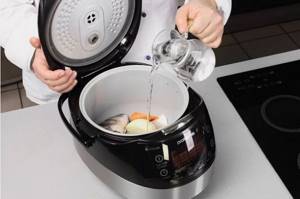
- Place the pike perch fillet on the steaming grill and salt it. Place a rack over the bowl in the multicooker and cook for another 20-25 minutes in the “Soup” mode until the fillet is completely cooked and remove it from the multicooker.
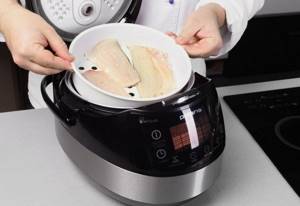
- Pour gelatin into the broth, stir and keep it in the multicooker in the “Heat” mode for 10-15 minutes. Then strain the broth through a fine sieve.
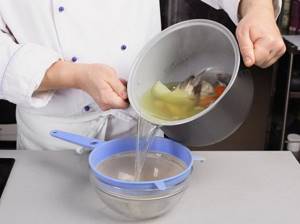
- We cut the fillet and arrange it into molds, add parsley leaves and slices of boiled carrots to the meat as decoration, fill the molds with broth, and cover with cling film. After the aspic has cooled to room temperature, put the molds in the refrigerator for 2-3 hours. In order to carefully remove the aspic from the molds, lower the bowl into hot water for 10 seconds and turn it over onto a flat dish. This cold appetizer will look very original.
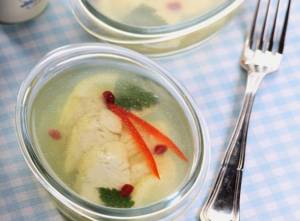
Bon appetit!
Instructions
First you need to prepare the pike perch
to salting. To do this, rinse it thoroughly under running cold water until the mucus disappears.
Clean the washed fish from scales and gut all the insides. It is important not to damage the bile. Otherwise, the fish will become bitter, making it unfit for consumption.
If the fish is large, then it is necessary to make an incision along the back to avoid subsequent damage.
Then rinse off the pike perch
remnants of scales and blood.
Take 150 grams of coarse table salt (you can use sea salt). Rub the entire fish thoroughly, paying special attention to the gills and the cut along the back (pour salt into these places). It is better to use more salt than not enough salt (then it will definitely not spoil).
Pike perch prepared in this way
place belly up in the barrel. The container must be clean and free of foreign odors. At the same time, do not forget to sprinkle the rows with salt, peas and bay leaves. Spices will give your fish a unique taste. The most salt should be in the top rows.
Close the barrel with a wooden lid and place pressure on top.
Large fish should be salted in a cool place for 15 days, and small fish should be salted for 4 to 5 days.
Not very fatty fish, such as pink salmon, are suitable for salting in brine. Raw fish must be removed from entrails and bones and washed well. The fillet, cleaned and cut into portions, is placed in a container of a suitable size, which is wide enough in diameter so that the brine can cover each piece of fish.
Drying pike perch:
After salting, remove all salt.
To get a tasty and aromatic product, and not just a lot of salt, you need to soak the pike perch.
To do this, place it in a suitable container, fill it with chilled boiled water and let it sit for as many hours as the fish was salted for days. We change the water every two to three hours.
To prevent the belly from rotting and to dry well, I make sure to install spacers.
After soaking and installing the spacers, first hang the pike perch over some container so that the water drains from it. For hanging, I use a stand that I made from wooden skewers. I hang fish on skewers, through the eye. Then we put it in a dry and not hot room to dry. A light breeze is also welcome. I dry it in the kitchen, under the ceiling. Dry for a week, after which you can try.
How to salt pike perch caviar in films
Salted caviar is delicious with butter and herbs. After pouring boiling water over the caviar, stir it for several minutes and steam it at the same time, then rinse with cold water until all the pieces of the film are washed off. Then transfer to a bowl, add salt and white pepper, lemon juice and a little vegetable oil. After cooling, the dish is ready for sampling. The result is five-minute lightly salted caviar. It’s even better to first pour the boiling solution over the caviar three times, each time preparing a new portion of water and salt. Well-steamed caviar with a pleasant golden hue. Another option. Place the caviar in boiling brine (or add brine).
Fish in milk
If, among other products, you took concentrated milk on a fishing trip, then I advise you to use it to prepare a simple and very tasty dish that can be eaten both hot and cold. Cut any fish that is not too fatty into fillets, roll in flour and fry in vegetable oil. Place the pieces in a thick-walled pan, pour boiling canned milk, add a couple of chopped onions, salt, pepper, sweeten to taste and simmer over very low heat (preferably over coals) until the sauce thickens. You can also use ordinary milk, but it still won’t taste as good.
How to salt red fish at home - Chum salmon Pink salmon Trout secret recipe
Spring fishing for perch in March using jigs, vertical lures and balance beams. Salt in enamel, wooden, food-grade plastic containers that have holes for liquid drainage. Home-salted caviar is especially good when paired with rye bread.
Often dried fish is made from roach, sprat, sardine, pike perch, bream, anchovy, rudd, perch, ide, pink salmon, trout, roach, carp (pay attention to the beautiful photos of ready-made delicacies). The entrails of large fish are removed, the milk and caviar are left, and the backs are cut.
If you wish, you can also rid the fish of its very fatty underbelly; not everyone is ready to eat such a delicacy. Prepare the pickling mixture. To do this, take salt and granulated sugar in a 1:1 ratio, pepper and other spices are added to taste. Stir the resulting mixture thoroughly; it will be sprinkled on the fish for salting. Video on how to salt red fish quickly and easily.
Properly cooked fish will always have a pleasant smell. In addition, the best time for drying is when there are few flies. There are many recipes for pickling. Whole salted mackerel can be quickly prepared at home when you have this simple recipe on hand. The proposed quick recipe for salting fish in brine is suitable for preparing small fish. Both sea and river fines are suitable for salting and subsequent drying according to this recipe. Tasteless salted store-bought fish can ruin everything. This is where our homemade recipe for salting fish such as sprat, herring or herring will come to the rescue. The so-called “wet” salting or salting fish in brine is used most often if there is a lot of fish and rubbing each one with salt becomes troublesome and tiring.
To salt fish roe at home, you will need an enamel pan, gauze, as well as water, salt, and seasonings (bay leaf, black and allspice). Recipe for salting perch caviar: Rinse the perch caviar under warm running water. During the washing process, do not remove the caviar from the bags. Place caviar in the last one. Boil it for 15–20 minutes. During the cooking process, caviar must be stirred with enviable regularity. Home-salted pike caviar is an exquisite delicacy. Rinse the pike caviar and remove the eggs from the bags, making sure that there are no remaining film residues in the caviar.
Dried fish is easy to prepare at home; there are many excellent ways to salt this product.
Predatory fish, which undoubtedly includes pike perch, has not too fatty white meat, which is easily dried and withered. And pike perch, moreover, has very few bones, and eating it dried is a pleasure. And also dried pike perch - this is one of the most important ingredients of the Portuguese dish gratinado! So, let's prepare the best dried pike perch at home, and then make a hearty Portuguese dinner out of it!
Salting pike perch at home
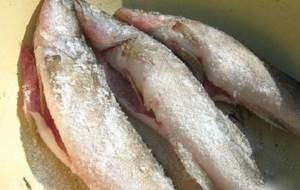
Having completed the primary processing, the fish must be sprinkled with salt, seasoned with spices and pressed. After 10-12 hours, brine or brine is formed, which is drained after 5 days, and the fish is used for food, dried or smoked. There are a lot of homemade salting recipes, and they differ in the amount of salt, different proportions of spices and herbs. Fresh fish, caught independently or purchased specifically for these purposes, is salted.
Salting fish ensures its preservation for a long time, as it prevents the penetration of bacteria. To do this, take 140 g of salt, bay leaf, allspice for 1 kg of pike perch and start salting:
- First, the mucus is washed off the fish with a hard sponge, and the scales and entrails are removed. Heads or gills - optional.
- For large fish, cuts are made along the ridge so that the salt penetrates evenly and washed.
- Rub thoroughly with salt, not forgetting the abdomen, gills and cut.
- Then they place it belly up in an enamel bowl or wooden barrel, sprinkling the rows with salt and spices. In this case, there should be slightly more salt in the upper part of the container than at the bottom.
- Cover with a wooden circle or flat plate and place the weight.
- Take it to a cool place.
Recommended reading: How to cook river perch in the oven
On a note! For large specimens it will take 7-8 days, for small ones – 3-5 days.
To prepare salted pike perch according to an old recipe, you will need to take:
- 8 kg pike perch;
- 50 g dried hops;
- 10 g cloves;
- Bay leaf;
- 10 g allspice;
- 10 g black pepper;
- 2.5 tbsp. coarse salt.
Pour a little salt into the bottom of the pan and place the pike perch prepared as in the previous recipe. Then lay the fish very tightly and sprinkle each layer with salt. Place a weight on top and take it to a cool place.
How to pickle pike perch for hot smoking
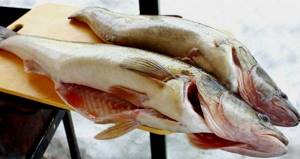
If you can’t catch fish yourself, you can buy it. In this case, you should be guided by the following rules:
- The size of the carcasses should be approximately the same.
- Frozen or chilled fish should be free of visible damage, mucus and unpleasant odor.
- The eyes are clean, transparent, the gills are bright red or pink.
For hot smoking, it is enough to use a quick salting method. The fish is rubbed with salt from the outside and inside, and placed under pressure. After 2-3 hours it is ready for hot smoking. You should not be afraid to oversalt the pike perch - it will not take more salt than it needs. But under-salted fish will not be as tasty as we would like.
Pike perch is smoked with hot smoke (90-100 degrees) and served hot. Shelf life in the refrigerator is 3 days.
Salting for withering
For drying, it is better to take medium-sized fish of medium fat content - it does not need to be gutted. If the pike perch is large, then it will have to be gutted and cut crosswise into 150-200 g pieces. The fish is salted in the same way as in the previous recipe - dry or in brine. In the latter case, the brine is prepared at such a strength that a raw chicken egg floats on the surface. Then they pour it over tightly packed pike perch, put it under pressure and take it out into the cold. After 3 days you can start soaking and drying.
We recommend reading: How to deliciously smoke pink salmon using a hot method
Salting predatory fish: how to prepare pike perch for drying
First of all, let’s select medium and small pike perch from the catch: they will pickle faster and dry better, and large pike perch can be prepared in many different ways. And besides the fish itself, which, by the way, we take about 4 kilograms, we need:
- horseradish leaves - 400 grams,
- dill seed (you can take fennel seeds) - 100 grams,
- 1 kilogram of coarse rock salt,
- table vinegar 9% - 200 milliliters,
- milk or kvass - 250 milliliters (can be omitted).
We begin preparing dried pike perch, as always, by cleaning the fish. We gut the pike perch (if you are drying for the first time, it is necessary; if you already have experience in drying and drying, you can leave the giblets inside, but then the taste will be sharper, with a bitter taste). Then we remove the scales slightly, cut out the gills and remove the eyes. Now the pike perch need to be thoroughly washed and dried a little with towels. Rub each carcass with vinegar and then a handful of coarse salt.
Chop the horseradish leaves and mix with dill (fennel) seeds. Pour a half-finger-thick layer of salt into the bottom of a plastic container. Place the pike perch on top of the salt in a jack-like pattern, again pour salt and mixed leaves with seeds on top. So we alternate until all the fish is in the container, covered with salt and spicy mixture. Leave the container covered for a couple of days in the refrigerator.
The salted fish then needs to be soaked to remove excess salt. Add milk or kvass to the soaking water, then the taste will be more pleasant. Place the soaked pike perch again on towels and dry a little.
How to bake pike perch in salt
- For cooking, it is better to take not frozen, but fresh or chilled fish (you can cook not only pike perch in this way, but I will have pike perch). The fish must be gutted and the gills removed. The scales do not need to be removed, since the finished fish is served without skin, and the scales will be removed along with it.
- Rinse the gutted carcasses well. There is no need to salt them, as the fish will be coated in salt and will take as much of it as needed during cooking.
- Now pour coarse salt into a container, pour in water and egg white. You can add dry thyme or rosemary to the salt.
- Use your hands to mix the salt mixture until it forms a sort of snowball—when you squeeze the mixture, it should form a dense lump that doesn’t crumble.
- On a baking sheet, pour part of the salt mixture in the shape of the fish, but a little more of it.
- Sprinkle the pike perch with lemon zest and place lemon slices, dill, parsley, and fennel seeds inside the belly. You can put dill and parsley under the gills. In a word, flavor it as you like. Place fish on salt.
- Cover the top of the carcass with the rest of the salt mixture and press well so that it is completely covered with salt. Bake this salt “block” for 30 minutes at 200 degrees. You can put garlic on a baking sheet along with the fish.
- When the cooking time is up, remove the pan from the oven.
- The salt crust will become very hard after baking, so you need to break it with a hammer or a knife.
- Pry the crust under the edges and carefully remove pieces of salt. After removing the salt from the fish, you can throw it away; you won’t need it anymore.
- All that remains is to cut the carcass along the back with a sharp knife and remove the skin.
- Beneath it awaits us juicy and tender pike perch pulp.
Serve the baked pike perch whole or in portions. Tartar is suitable as a sauce for this dish, and fresh or baked vegetables as a side dish.
Drying pike perch, secrets and technology for the home
It is quite possible to prepare dried pike perch at home if you have an open balcony or veranda. It is enough to adhere to the technology:
- we string fish carcasses onto twine through the eyes, interspersing pike perch with knots so that they dry at a distance of at least 10 centimeters from each other;
- we hang the twine with fish on the balcony or covered veranda;
- dry for about 2 weeks in dry and warm weather, for the cold season we increase the time by another week;
- We ensure a constant flow of fresh air and breeze to the pike perch so that they dry evenly. In wet weather, it is better to close the windows and place a fan on near the fish;
- In summer, one of the scourges is flies. You can protect fish from them by lubricating it with vegetable oil or sprinkling it with vinegar during the first week of drying. You can also make a curtain from gauze or fine mesh;
- You can check the readiness of pike perch by slightly cutting or breaking the carcass in the back area: the meat should acquire a beautiful amber hue and, when cut, give off a rich, pleasant aroma.
Dried pike perch can be stored in the refrigerator for quite a long time - up to several weeks, although such a tasty delicacy is usually eaten very quickly.
Drying pike perch:
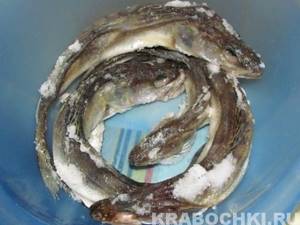
After salting, remove all salt.
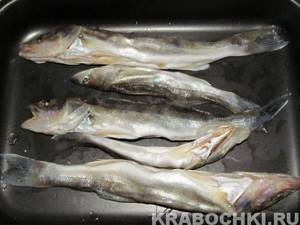
To get a tasty and aromatic product, and not just a lot of salt, you need to soak the pike perch.
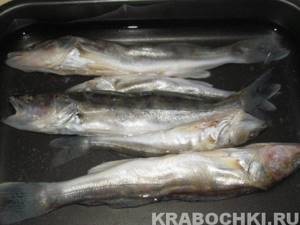
To do this, place it in a suitable container, fill it with chilled boiled water and let it sit for as many hours as the fish was salted for days. We change the water every two to three hours.
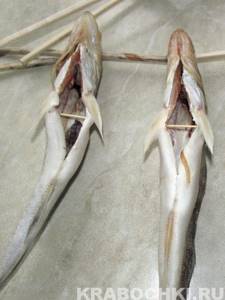
To prevent the belly from rotting and to dry well, I make sure to install spacers.
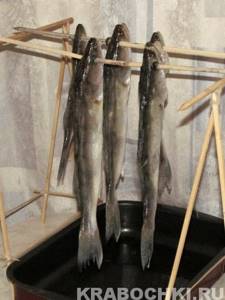
After soaking and installing the spacers, first hang the pike perch over some container so that the water drains from it. For hanging, I use a stand that I made from wooden skewers. I hang fish on skewers, through the eye. Then we put it in a dry and not hot room to dry. A light breeze is also welcome. I dry it in the kitchen, under the ceiling. Dry for a week, after which you can try.
Gratinado with dried pike perch
Portuguese cuisine is based on fish and seafood. And often dried fish is used in cooking, as in our next recipe. For gratinado we will need:
- dried pike perch - 1 carcass;
- smoked or dried bream - ½ carcass (you can not use it, limit yourself to pike perch);
- milk - 1 glass;
- boiled water - 1 glass;
- onions - 2 pieces;
- vegetable oil - ½ tablespoon;
- potatoes - 4 tubers;
- fresh mushrooms (champignons) - 300 grams;
- cream or sour cream 25% - 1 cup;
- salt and herbs - to your taste.
- Number of servings: 4;
- Preparation time: 2 days + 1.5 hours.
We divide the pike perch and bream in two along the back, stretch out the ridges and large bones, and remove the skin and scales. Cut the fish into strips and place in a deep container. Mix milk and water and pour ¼ of the mixture over the fish pieces.
After 12 minutes, drain the water and soak the fish again. We repeat this twice more. When the excess salt comes out of the fish, it’s time to prepare the dish itself. Peel the onion and cut into half rings, and peel and cut the potatoes into circles. Lightly wipe the champignons from dirt with a sponge and cut into slices.
Pour a couple of drops of oil into a baking dish or deep frying pan and spread with a brush or hand over the entire surface. Place onion rings and fish strips on them. Place a layer of potato circles on the pike perch with bream, and a layer of champignons on top. Fill the mold with cream or sour cream, cover with foil and place in the oven for 1 hour at 180 degrees. 20 minutes before cooking, remove the foil. Gratinado is served hot, straight from the oven.
Step-by-step recipe for jellied pike perch with mayonnaise
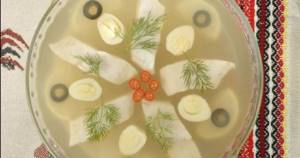
Classic food is always good, but sometimes by deviating a little from the standards, we get a new interesting dish. In this recipe we will supplement the usual pike perch aspic with mayonnaise.
Ingredients:
- Pike perch – 800-1000 gr.
- Mayonnaise – 100 gr.
- White bread pulp – 80 g.
- Gelatin – 30 gr.
- Garlic – 2-3 cloves.
- Onion – 1 pc.
- Carrots – 1 pc.
- Parsley root.
- Olives.
- Milk – 2 tbsp.
- Spices (allspice, black pepper, bay leaf) - to taste.
- Salt - to taste.
- Greenery.
Cooking process:
- We cut the fish as follows: separate the head, remove the gills and eyes, cut off the tail and fins, cut the fillet into several parts.
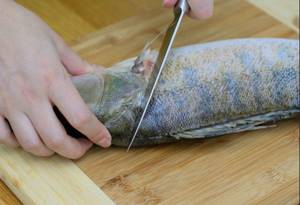
- Cook fish broth from the head, fins, and bones of the fish, after 40 minutes add spices, salt, vegetables and parsley root to the broth, cook for another 30 minutes over low heat.
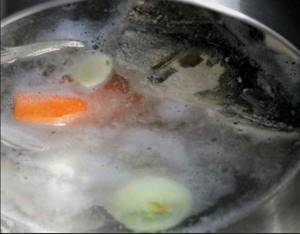
- Soak the gelatin in cool boiled water, put it on the stove, bring to a boil and turn off the heat.
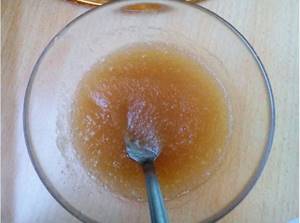
- Strain the fish broth, mix it with gelatin, divide into 2 parts. Mix one part of the broth with mayonnaise, leave the second.
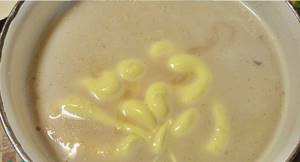
- Soak the bread in milk. To it we add fillet, chopped garlic, grind the resulting mass with a blender or pass through a meat grinder, salt and add spices to taste. Transfer the resulting mass into a plastic bag, seal tightly and cook for 1.5 hours.
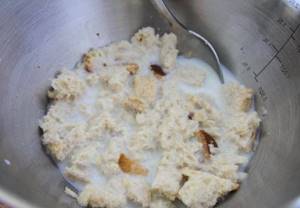
- Pour the entire portion of the clear broth into the aspic mold. Cool the finished roll and cut it into slices up to 1 centimeter thick diagonally, place them in the mold so that they slightly overlap each other. Let the broth harden a little, then pour some of the broth mixed with mayonnaise on top, and decorate with herbs on top. Place the dish in a cold place so that the aspic hardens. This dish can be served to the table in portions if it is cut into slices.
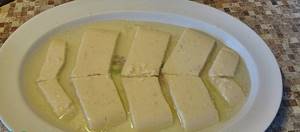
Bon appetit!
